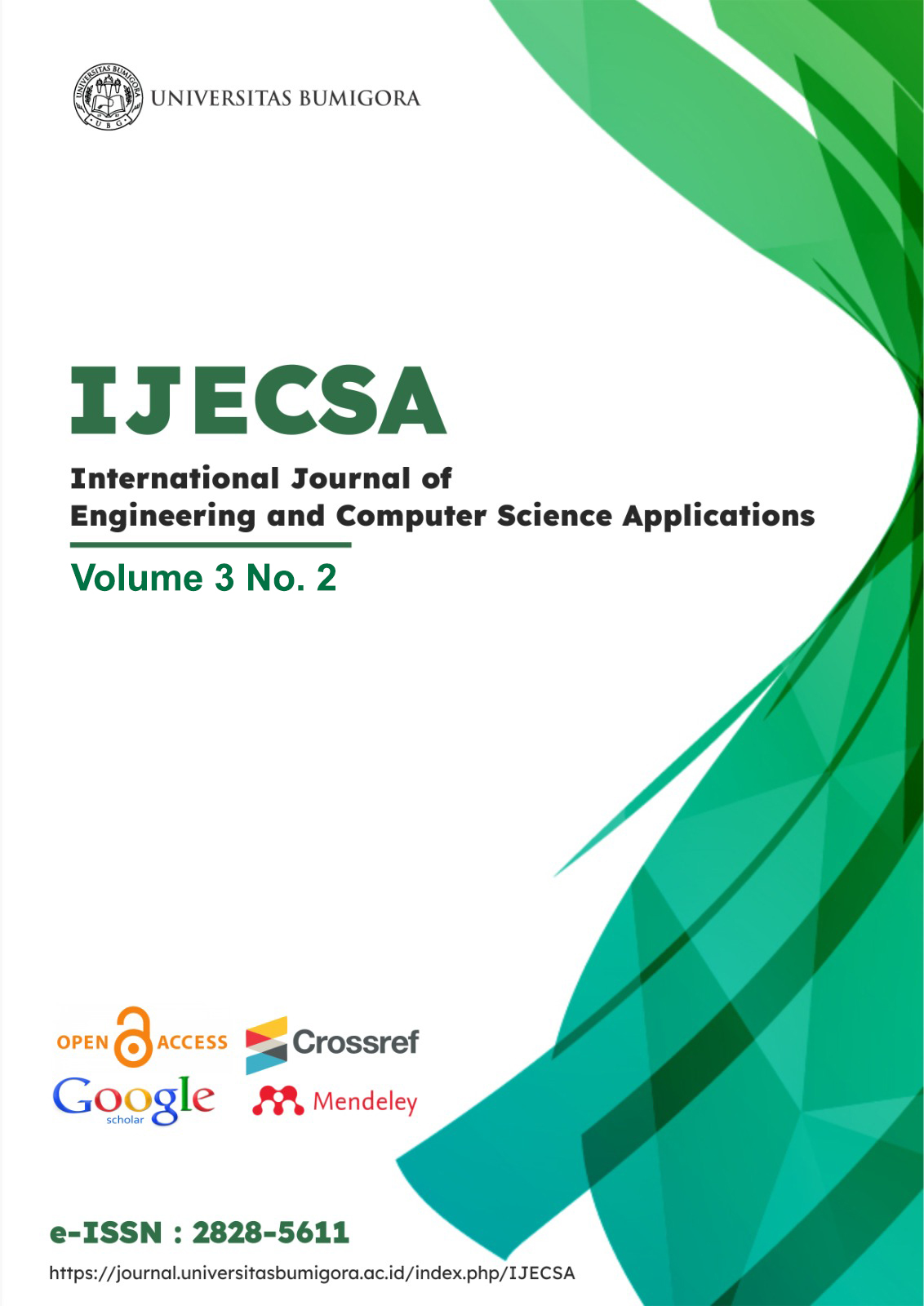Clustering Analysis of Umrah Pilgrim Data Based on the K-Medoid Method
Abstract
The Umrah pilgrimage is becoming increasingly popular among Indonesians, with millions of participants yearly. This trend creates a need for service providers to understand the characteristics of pilgrims to improve service quality, marketing strategies, and competitiveness. Analyzing data on pilgrims helps service providers develop more effective strategies and tailor packages to match their needs, ensuring competitiveness in a growing market. This study aims to clusters Umrah pilgrims based on age, gender, district, and chosen package using the K-Medoid clustering method. This research uses the K-Medoid method for the reason that it is more resistant to noise and outliers compared to other clustering methods. The most centrally located point in the data set is called a ”medoid,” which is an object in a cluster that has the lowest difference to all other objects in the cluster. The results of this study are that the K-Medoid method successfully grouped pilgrims into three clusters: Cluster 1 with 63 members, Cluster 2 with 25 members, and Cluster 3 with 25 members. The findings indicate that the Milad Mastour package is preferred by older pilgrims, primarily from Mataram and West Lombok. The Arbain package is favored by younger pilgrims from the same regions, while adult pilgrims mostly choose the Regular package. The implication of this research is that it can provide insights for service providers to design more specific programs that align with the profiles of pilgrims based on age and district.
References
[1] D. Nurohman, N. R. Sari, R. Himmati, and R. Mas’ud, “Marketing Strategy of Umrah Travel Agent and Religious Attitude in Indonesia,” International Journal of Scientific Research and Management, vol. 11, no. 02, pp. 4528–4529, 2023.
[2] M. Aulia, Y. Affandi, and A. Rozaq, “Tren dan Tantangan dalam Manajemen Industri Haji dan Umroh : Perspektif Global dan Lokal,” Jurnal Manajemen Pendidikan dan Ilmu Sosial, vol. 5, no. 4, pp. 1224–1233, 2024.
[3] S. F. Rahman, M. Saggaff Shihab, and H. Hammad, “Membangun Kepuasan Pelanggan Jamaah Umroh Melalui Aktivitas Komunikasi Pemasaran dan Persepsi Harga,” Jurnal Administrasi dan Manajemen, vol. 13, no. 3, pp. 294 306, 2023.
[4] D. K. Putri and A. Rozaq, “Studi Komparatif Pemasaran Paket Umroh dalam Meningkatkan Jumlah Jamaah pada PT. Mahabbah Wisata Semarang dan PT . Arrahmah Kendal,” Al Qalam: Jurnal Ilmah Keagamaan dan Kemasyarakatan, vol. 18, no. 4, pp. 2339–2351, 2024.
[5] V. N. A. S. Romli, “Strategi Pemasaran Paket Ibadah Haji Dan Umroh Dalam Merekrut Jamaah Di PT. Sela Express Tour Kota Pekanbaru,” Jurnal Riset Mahasiswa Dakwah dan Komunikasi, vol. 1, no. 9, pp. 1689–1699, 2019.
[6] I. Zulfikar and A. Palewa, “Analisis Strategi Pemasaran Dalam Rangka Meningkatkan Kualitas Pelayanan Terhadap Jamaah Umroh Pada PT. Daanish Mika Salsa Di Bandar Lampung,” Jurnal Manajemen Mandiri Saburai (JMMS), vol. 3, no. 01, pp. 1–8, 2020.
[7] M. Chaudhry, I. Shafi, M. Mahnoor, D. L. R. Vargas, E. B. Thompson, and I. Ashraf, “A Systematic Literature Review on Identifying Patterns Using Unsupervised Clustering Algorithms: A Data Mining Perspective,” Symmetry, vol. 15, no. 9, pp. 1–44, 2023.
[8] D. Susilowati, H. Hairani, I. P. Lestari, K. Marzuki, and L. Z. A. Mardedi, “Segmentasi lokasi promosi penerimaan mahasiswa baru menggunakan metode rfm dan k-means clustering,” MATRIK: Jurnal Manajemen, Teknik Informatika dan Rekayasa Komputer, vol. 21, no. 2, pp. 275–282, 2022.
[9] B. Artha, I. Zahara, and N. P. Sari, “Customer Retention : A Literature Review,” Social Science Studies, vol. 2, no. 1, pp. 30–45, 2022.
[10] H. Hairani and J. X. Guterres, “Exploring customer purchasing patterns: A study utilizing fp-growth algorithm on supermarket transaction data,” International Journal of Engineering and Computer Science Applications (IJECSA), vol. 3, no. 1, pp. 33–42, 2024.
[11] T. Hidayat, “Klasifikasi Data Jamaah Umroh Menggunakan Metode K-Means Clustering,” Jurnal Sistim Informasi dan Teknologi, vol. 4, no. 1, pp. 19–24, 2022.
[12] M. Hermansyah, R. A. Hamdan, F. Sidik, and A. Wibowo, “Klasterisasi Data Travel Umroh di Marketplace Umroh.com Menggunakan Metode K-Means,” Jurnal Ilmu Komputer, vol. 13, no. 2, p. 8, 2020.
[13] M. Yunitasari, T. Maharani, and B. Hikmahwan, “Implementasi Metode K-Means Untuk Pengelompokan Data Jamaah,” Kumpulan jurnaL Ilmu Komputer (KLIK), vol. 09, no. 1, pp. 1–9, 2022.
[14] A. Wijaya Kusuma and D. Mahdiana, “Development of Data Warehouse To Predicate the Regarding of Umroh
Congregations Using the Manearest Neighbour Algorithm (Case Study Pt. Bahana Sukses Sejahtera),” Jurnal Teknik Informatika (JUTIF), vol. 3, no. 4, pp. 1007–1012, 2022.
[15] F. A. Sianturi, M. Kumari, and E. Laian, “Implementasi Algortima C4.5 Menentukan Pola Berangkatan Jamaah Haji,” Jurnal Sains dan Teknologi, vol. 3, no. 2, pp. 66–70, 2022.
[16] M. Iqbal, “Klasterisasi Data Jamaah Umroh Pada Auliya Tour & Travel Menggunakan Metode K-Means Clustering,” JURTEKSI (Jurnal Teknologi dan Sistem Informasi), vol. 5, no. 2, pp. 97–104, 2019.
[17] N. Rizqia and P. Ratnasari, “Comparative Study of k-Mean , k-Medoid, and Hierarchical Clustering,” Indonesia Journal of Life Sciences, vol. 5, no. 2, pp. 9–20, 2023.
[18] R. A. Farissa, R. Mayasari, and Y. Umaidah, “Perbandingan Algoritma K-Means dan K-Medoids Untuk Pengelompokkan Data Obat dengan Silhouette Coefficient,” Journal of Applied Informatics and Computing (JAIC), vol. 5, no. 2, pp. 109–116, 2021.
[19] H. L. Siregar, M. Zarlis, and S. Efendi, “Cluster Analysis using K-Means and K-Medoids Methods for Data Clustering of Amil Zakat Institutions Donor,” Jurnal Media Informatika Budidarma, vol. 7, no. 2, p. 668, 2023.
[20] N. Mirantika, T. S. Syamfithriani, and R. Trisudarmo, “Implementasi Algoritma K-Medoids Clustering Untuk Menentukan Segmentasi Pelanggan,” Jurnal Nuansa Informatika, vol. 17, no. 1, pp. 2614–5405, 2023.
[21] T. Hassan, M. Carvache-Franco, O. Carvache-Franco, and W. Carvache-Franco, “Sociodemographic relationships of motivations, satisfaction, and loyalty in religious tourism: A study of the pilgrimage to the city Mecca.” PloS one, vol. 18, no. 3, pp. 1–17, 2023.

This work is licensed under a Creative Commons Attribution-ShareAlike 4.0 International License.












